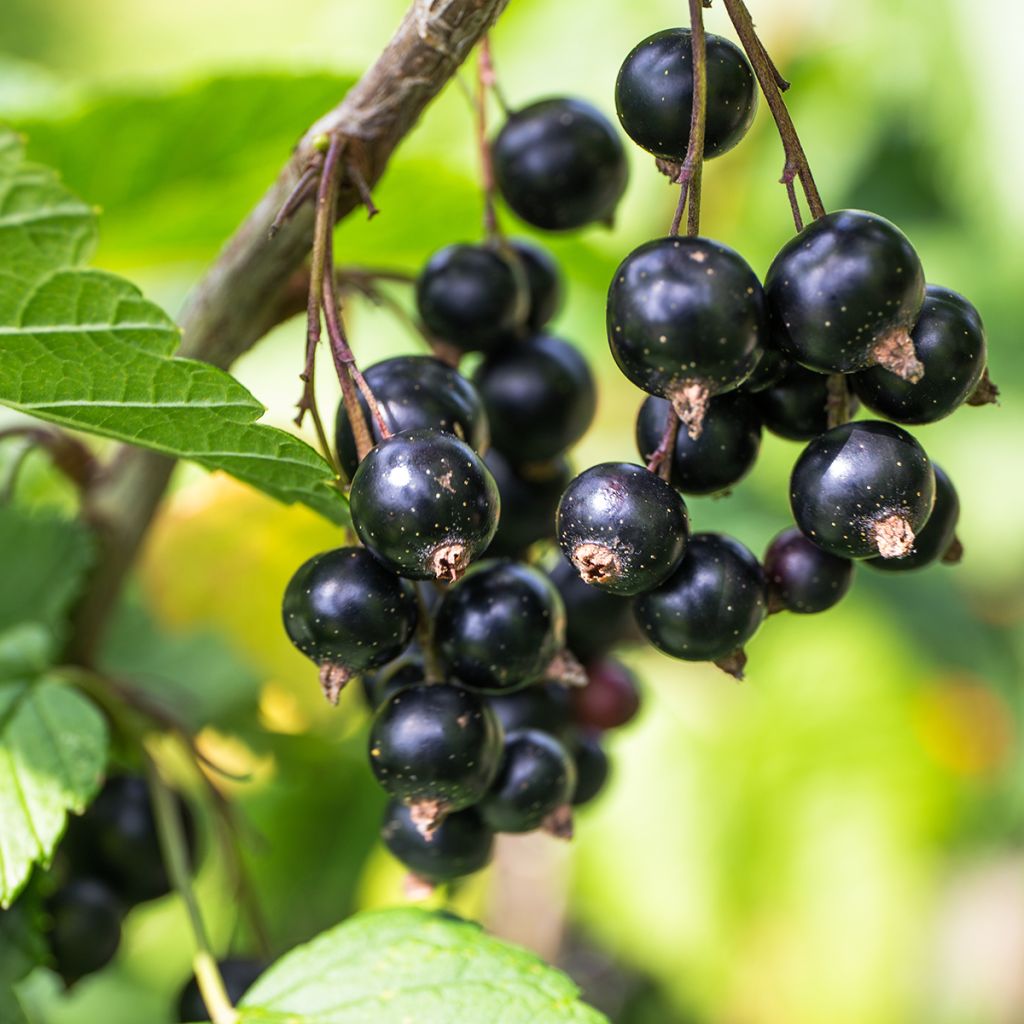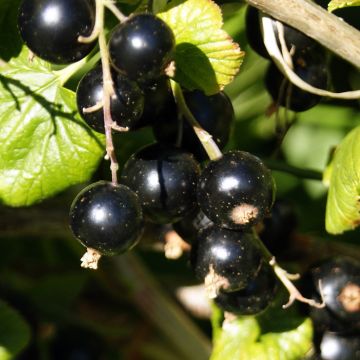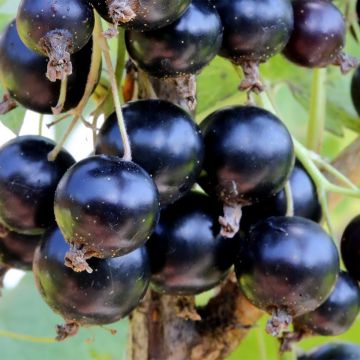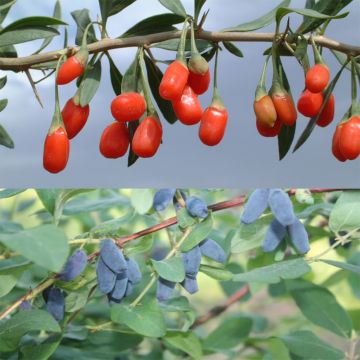

Ribes nigrum Cassisima® Blackbells®
Ribes nigrum Cassisima® Blackbells®
Ribes nigrum Cassisima® Blackbells®
Blackcurrant
This item cannot be shipped to the selected country
Delivery charge from €5.90
More information
Delivery charge from €5.90
More information
Schedule delivery date,
and select date in basket
This plant carries a 6 months recovery warranty
More information
We guarantee the quality of our plants for a full growing cycle, and will replace at our expense any plant that fails to recover under normal climatic and planting conditions.
From €5.90 for pickup delivery and €6.90 for home delivery
Express home delivery from €8.90.
Description
The 'Blackbells®' Blackcurrant bush is a recent creation, resistant to powdery mildew and leaf curl. It stands out from other blackcurrant varieties with its very long clusters of black fruits. Easy and quick to pick, the large berries, with juicy pulp, surprise with their strong blackcurrant flavour and intensely sweet taste. They can be enjoyed fresh to appreciate all the flavors, or transformed into sweet jellies or jams. They can be used to garnish pastries and enhance savoury dishes. Plant from October to March for a harvest that will begin around mid-July.
The Blackcurrant bush, known in Latin as Ribes nigrum, is sometimes commonly called the blackcurrant or black gooseberry. It belongs to the Grossulariaceae family, like the redcurrants and gooseberries, from which it is distinguished by its black fruits. Its origins in temperate regions of Northern Europe and Asia give the blackcurrant bush a very good cold resistance. Cultivated since the 16th century, the blackcurrant bush grows spontaneously in the cool woods of Northeast Europe. Historically, it has been mainly used as a medicinal plant, with apothecaries and healers attributing powerful virtues to it.
Ribes nigrum Cassissima® 'Blackbells' ® is a recent Swiss creation from the Cassissima® range. This range consists of blackcurrant varieties selected for their high yields, juicy fruits with high sugar content, on vigorous and disease-resistant plants. It forms a bushy, non-thorny shrub with a clump-like habit of slightly stiff, sparsely branched twigs, with soft wood and abundant pith. This very hardy bush reaches a height of 1.30m (4ft) with a spread of 1m (3ft). The foliage is deciduous, composed of palmate, lobed, medium green leaves. It is particularly aromatic and pleasantly fragrant when crushed. Leaves, fruits, and buds are intensely fragrant due to the presence of glands containing essential oils used in perfumery. This variety of blackcurrant blooms in April, in the form of clusters of small greenish to brownish flowers, quite insignificant but intensely visited by bees. The fruiting mainly develops on 2- and 3-year-old twigs and is rarer on older ones. Moderately late, it produces very long clusters of 10 to 15 black berries, large in size, about 1cm (0.3in) in diameter, with fleshy and juicy pulp, very sweet, with sweet and pleasant flavors, marked by a slight hint of acidity. When ripe, the berries are black, round, and filled with juicy flesh, containing very few tiny seeds.
The 'Blackbells' blackcurrant bush is self-fertile, so it does not need a companion to fruit, but the presence of another variety nearby will increase production. The harvest is staggered as the fruits ripen, and is simplified by the size of the berries. A blackcurrant bush can produce about 3 to 5kg of fruit per plant depending on the age and growing conditions of the plant.
All blackcurrant varieties are rich in vitamin C, antioxidants, minerals, and trace elements, as well as potassium, calcium, and phosphorus, making them real assets for health. Furthermore, they are among the least energy-rich small fruits (50 kcal per 100g). When enjoyed fresh, they are rich in nutrients. They can also be used to prepare jellies, jams, pies, cakes, sorbets, ice creams, and milkshakes. They are perfect for accompanying fruit salads and red meats, or as a touch in mixed salads. They can also be transformed into juice or syrup, and into liqueur to flavour Kir, cocktails, and Sangria.
Forming a wide, upright shrub with a fairly compact growth habit and healthy foliage, the 'Blackbells' blackcurrant bush is easy to integrate into a productive garden. In addition to fruiting, the beautiful dark green deciduous leaves and the colorful winter wood give this fruit tree appreciable ornamental qualities throughout the year. Very hardy (down to -25°C (-13°F)), it prefers a sunny but not scorching exposure, or partial shade. It is easy to grow and maintain in well-drained, fresh soil, but not constantly wet.
In summer, the blackcurrant bush adds a decorative touch to your garden with its clusters of black berries. You can associate it with redcurrants, raspberries, or other small fruit varieties to form a delicious hedge. In a blackcurrant plantation, as in any plantation, it is important to alternate species and varieties where possible. This promotes pollination, even if the variety is self-fertile, and reduces the risk of diseases. It can be grown in a pot, but you should choose a container at least 40cm (16in) tall and water regularly with non-calcareous water.
Ribes nigrum Cassisima® Blackbells® in pictures


Plant habit
Fruit
Flowering
Foliage
Botanical data
Ribes
nigrum
Cassisima® Blackbells®
Grossulariaceae
Blackcurrant
Cultivar or hybrid
Other Blackcurrant bush
Planting and care
Plant the Blackcurrant bush from October to March, avoiding periods that are too cold or too wet. It thrives in ordinary soils, even poor ones, without too much limestone. The Blackcurrant bush prefers well-drained, cool soil, but not constantly wet. Avoid planting in hot and dry conditions. Choose a location sheltered from strong winds.
When planting, space the plants 1.20m (4ft) apart in all directions. For bare-root plants, soak the roots in a praliné mixture to prevent air pockets between the roots and the soil. You can prepare the praliné mixture by combining 1/3 fine soil or compost, 1/3 cow manure or compost, and 1/3 rainwater, or you can purchase it commercially. Dig a hole, incorporate decomposed manure or well-aged compost into the soil, place the plant, and cover with soil. Water thoroughly. Then mulch the soil to retain moisture in the summer.
For container cultivation: use a mixture of potting soil and loam, with a drainage layer at the bottom of the perforated pot. Feed your Blackcurrant bush with compost or fertilizer for small fruits and water regularly to keep the substrate slightly moist, but not waterlogged.
An application of organic fertilizer at the start of the growing season will support fruit production and plant health. The Blackcurrant bush is a resilient shrub, not very susceptible to diseases. It does have a few enemies, such as aphids, which can be eliminated by spraying with soapy water or a garlic decoction. In case of powdery mildew, spray with Bordeaux mixture. In June-July, protect the harvest with nets to deter birds. To get rid of raspberry worms, which can also affect Blackcurrant bushes, you can sow forget-me-nots along the plantation; they are reputed to repel the worms.
In a Blackcurrant plantation, as in any plantation, it is important to alternate varieties and species when space allows: this will promote pollination and limit the spread of epidemics or diseases.
Planting period
Intended location
Care
This item has not been reviewed yet - be the first to leave a review about it.
Berries
Haven't found what you were looking for?
Hardiness is the lowest winter temperature a plant can endure without suffering serious damage or even dying. However, hardiness is affected by location (a sheltered area, such as a patio), protection (winter cover) and soil type (hardiness is improved by well-drained soil).

Photo Sharing Terms & Conditions
In order to encourage gardeners to interact and share their experiences, Promesse de fleurs offers various media enabling content to be uploaded onto its Site - in particular via the ‘Photo sharing’ module.
The User agrees to refrain from:
- Posting any content that is illegal, prejudicial, insulting, racist, inciteful to hatred, revisionist, contrary to public decency, that infringes on privacy or on the privacy rights of third parties, in particular the publicity rights of persons and goods, intellectual property rights, or the right to privacy.
- Submitting content on behalf of a third party;
- Impersonate the identity of a third party and/or publish any personal information about a third party;
In general, the User undertakes to refrain from any unethical behaviour.
All Content (in particular text, comments, files, images, photos, videos, creative works, etc.), which may be subject to property or intellectual property rights, image or other private rights, shall remain the property of the User, subject to the limited rights granted by the terms of the licence granted by Promesse de fleurs as stated below. Users are at liberty to publish or not to publish such Content on the Site, notably via the ‘Photo Sharing’ facility, and accept that this Content shall be made public and freely accessible, notably on the Internet.
Users further acknowledge, undertake to have ,and guarantee that they hold all necessary rights and permissions to publish such material on the Site, in particular with regard to the legislation in force pertaining to any privacy, property, intellectual property, image, or contractual rights, or rights of any other nature. By publishing such Content on the Site, Users acknowledge accepting full liability as publishers of the Content within the meaning of the law, and grant Promesse de fleurs, free of charge, an inclusive, worldwide licence for the said Content for the entire duration of its publication, including all reproduction, representation, up/downloading, displaying, performing, transmission, and storage rights.
Users also grant permission for their name to be linked to the Content and accept that this link may not always be made available.
By engaging in posting material, Users consent to their Content becoming automatically accessible on the Internet, in particular on other sites and/or blogs and/or web pages of the Promesse de fleurs site, including in particular social pages and the Promesse de fleurs catalogue.
Users may secure the removal of entrusted content free of charge by issuing a simple request via our contact form.





















































